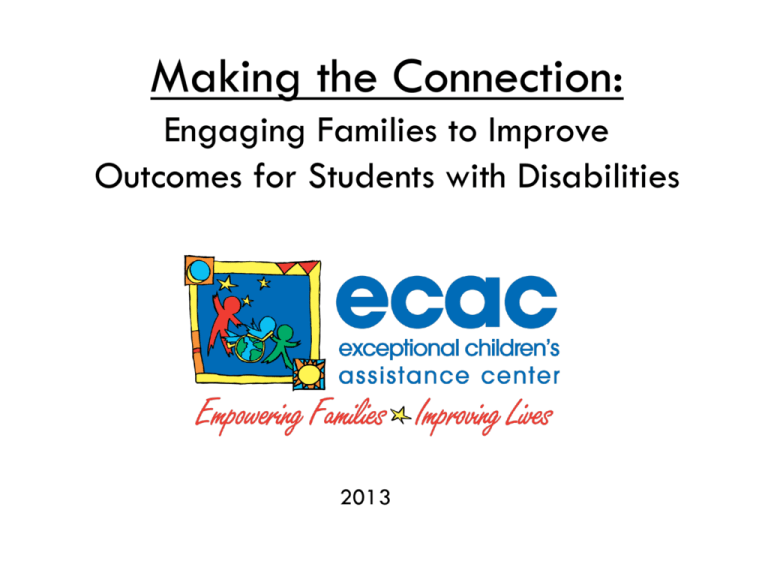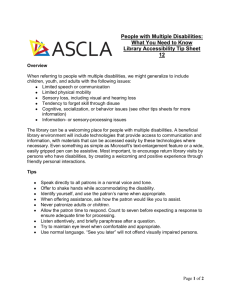Making the Connection - Exceptional Children's Assistance Center
advertisement

Making the Connection: Engaging Families to Improve Outcomes for Students with Disabilities 2013 ecac Empowering Families … Improving Lives Parent Training and Information Center (PTI) NC Family to Family Health Information Center (F2F) Individual Assistance Workshops on a variety of topics Toll free Parent Info Line Lending Libraries Newsletters Information packets Parent-to-Parent Support Assistance to parent groups 2 2012 The North Carolina State Improvement Project Improving Instruction For Students With Disabilities PURPOSE: To improve the quality of Instruction for students with disabilities. GOALS: Improve basic skills performance. Increase the percentage of qualified teachers of students with disabilities. Increase graduation rates and decrease dropout rates. Improve parent satisfaction and Involvement with, and support of, school services. Improve the quality of teachers instructional competencies www.ncsip.org 2012 3 Why does your work with families make a difference? Families’ involvement in their children’s education stands out as one of the greatest predictors of growth and well-being for students with disabilities. Elliott & Mullins, 2004; Resch et al., 2010 4 2012 Parent Involvement Benefits When parents are actively engaged in their children’s learning, students usually benefit in the following ways: New Wave of Evidence: The Impact of School, Family and Community Connection on Student Achievement, Anne Henderson and Karen Mapp Earn higher grades and better test scores; Enrolled in higher-level programs; Promoted more and pass more of their classes; Earn more class or course credits; Attend school more regularly, and drop-out less; Have better social skills and demonstrate better behavior; and Go on to postsecondary education or other productive life choices. 5 2012 Schools that succeed in engaging families from very diverse background share three key practices. They focus on building trusting, collaborative relationships. Schools recognize, respect and address family’s needs, as well as cultural and class differences. They embrace a philosophy of partnership where power and responsibility are shared. Ann Henderson and Karen Mapp (2002) 6 2012 The “Joining” Process Karen Mapp (2003) Describes how schools can successfully develop a culture that honors and validates parents as true partners in their child’s educational development that results in improved student learning. 1. 2. 3. Welcoming Honoring Connecting 7 2012 Welcoming Families are made to feel a part of the school community School facilities are welcoming. Staff, parents and visitors greet each other in genuinely friendly ways. School leaders, staff and parent groups are easily accessible. School staff are responsive to the different backgrounds and cultures of families. 8 2012 Honoring Family members are genuinely respected and affirmed for the contributions they make. The school community has a philosophy of true partnership, where power is shared. Parents are given a real voice in governance, with representation from a diverse group of families The school solicits and listens to ideas and is responsive to diverse needs of families. 9 2012 Research indicates… School personnel often treat poor families from a deficit perspective that becomes a barrier to family involvement. Strengths-based approaches can foster the school-home connection. 10 2012 Recognize the Roadblocks to Parent Engagement 2012 Time Not feeling welcomed Not knowing how to contribute (whether at school or with child) Educational background Not understanding the system Childcare Transportation Language Special needs Economic and other needs 11 Connecting School staff and families put children at the center. Work together on education issues designed to improve educational opportunities for the children. School program/ events are linked to improved student learning 2012 Equip parents with skills on how to help their children learn at home. Families know that school staff care about their students and have high expectations. School staff develop relationships with families. 12 Every family functions as a home learning environment, regardless of its structure, economic level, ethnic or cultural background. Consequently, every family has the potential to support and improve the academic achievement of its children. ~Unknown 13 2012 What do the numbers tell us? School-aged children in the US 32% are members of a single parent household 18% live below the federal poverty level 22% are members of an immigrant family (at least one parent) 6% do not live with either parent 41% do not have internet access 31% do not have a computer at home Teacher Demographics in the US 80% are White 79% are female Median Age is 46% 56% have a master’s degree 14 2012 To begin… You MUST identify the meaning of the word “family” in your school And…design your approach to include the families you don’t know not just the ones you do. 15 2012 It’s ALL in the APPROACH… The transmission approach Is NOT effective in parent involvement programs Knowledge emanates from an authority The parent is an empty vessel, which the educator fills. One size fits all. The transaction approach Cooperative interactions between educator and parent works! Opportunity to create a “dialogue” between educators and parents Meeting parents “where they are” Partnership and true collaboration. 16 2012 Remember, Research Shows… The most effective family engagement / involvement activities are what the parent does at home. 17 2012 What Parents Say… Tell us what our kids do. Show us how to tell if our kids are doing well. Explain Show how you teach skills, reading and math. us some strategies to help our kids. Tell us how our children will be assessed. Let us know how we can help you. 18 Anne Henderson, Annenberg Institute for School Reform 2012 Reaching Out to Diverse Families Actively welcome students and families. Involve family / community who speak the native language. Recruit staff volunteers who speak the same language. Invite families to celebrate the school’s diversity. Give parents a “school roadmap to learning” Hold classes for non-native English speakers. Meet families where they are. 19 2012 Instructions vs. Instruction 2012 20 2012 What type of information or support do teachers need to effectively encourage involvement by providing instruction not instructions? This teacher’s response to a question from a father is a great example of effective communication and instructions. Let him read for 15 minutes, and have him read out loud so you can hear him. And when he makes mistakes, don’t say “No, you know better than that…” go in there and say…”I think you’ve misread this” and “Let’s go over this”. 21 2012 Families may need information and guidance in how to create language rich environments and interactions Consider family culture and language differences when creating strategies / activities. Activities should help families see that reading and conversation about books can be FUN. Technology is both a barrier to family interactions and an effective tool in creating activities. 22 2012 Examples of Instruction: Echo Reading Choral Reading You and your child read the same text aloud together. Choral reading should be done at least 2x per week. Partner Reading You read one line and the child reads the same line after you. Increase the number of lines you read as the child’s reading improves. Try to echo read at least one story each week You and your child take turns reading. Start by reading one sentence and asking the child to read the next sentence. As the child’s fluency improves, you read one page and he/she reads a page. Partner read once a week. Repeated Reading Read the same book or story more that once in the same week. 2012 23 Remember… When you read with your child, use as much expression as you can so your reading sounds like speaking and the story comes alive. 24 2012 Effective activities at home should be designed to: Engage the family Reinforce current classroom instruction Review or practice basic skills Challenge students who are ready to move forward 25 2012 Reading and Math Activities at Home can be FUN and we know they make a difference in a student’s education. Remember, families say they need INSTRUCTIONS on how to help their child at home. 26 2012 Be creative with instructions for parents! TRY… Giving families step by step tip sheets explaining how to support reading or math at home Making “short videos” - modeling how to read with a child Inviting families to a “make it and take it” event at school and create tools for helping with reading and math Providing “words you should know” definitions so parents are talking the same language. 27 2012 Be creative with instructions for parents! TRY… Creating fill in the blank math stories to teach families how to use these at home Developing Q & A documents giving parents questions to explore with their child Sending home a weekly activity and directions… either by tweet, email, phone tree, website, and with the child. 28 2012 And don’t forget about using technology when appropriate 2012 Developing a “shared work” site such as Big Tent Offering skill building conference calls or webinars Communicating by tweet, email, website, etc. Using a BLOG to connect and educate families Maintaining an electronic calendar of assignments and activities 29 THINK about… Working with building leadership to ensure that all school wide parent events are welcoming and useful for ALL families Making home activities relate to the parent’s work, culture, family history or hobbies Identifying and using cultural mentors Using partners such as faith based and community organizations Creating parent to parent support and educational opportunities Providing opportunities for families who do not read or do math well to be successful at helping their child at home 30 2012 Are families of children with disabilities considered when planning BIG EVENTS in the building? Family Literacy / Math Nights Sports and Stories Meet the Press What am I eating? How does my family use Math? Book fair events Career math spotlight 31 2012 ecac will also be your PARTNER! We are creating Activity instructions Templates Flip videos and other tools Let us know what will be helpful! SIPParents@ecacmail.org 2012 32 In summary… Parents impact the individual child’s learning True collaboration is a process rather than an event The outcome should be parents who feel they are a valued and important part of their child’s education. 2012 33 The old way of thinking was that parent involvement was all about parents. The new way is that it’s about student success. Joyce Epstein 34 2012 Sources… Achievement Gaps: Family and Community engagement (2008) Henderson, A.T., Mapp, K.L., & Davies, D. , Beyond the Bake Sale: The Essential Guide to Family / School Partnerships. (2007) Iowa School Boards Foundation, Family, School, and Community Connections: Improving Student Learning (2007) Edwards, Caitlin C., & Da Fonte, Alexandra, The 5-Point Plan: fostering Successful Partnerships with Families of Students With Disabilities. Teaching Exceptional Children (Jan/Feb 2012) National PTA / building successful Partnerships, Barriers to Parent Involvement: Roadblocks and Detours. 35 2012 Sources… New Mexico Public Education Department (NMPED) and the Center for the Education and Study of diverse Populations (CESDP), Professional Development Tools: Improving Communication, Module 2. Project Appleseed, the Campaign for Public School Improvement, (2008) Rutgers University, Strategies for Effective collaboration with Parents, Schools and Community members, (Presentation 2009) Bringing Literacy Home, KaiLonnie Dunsmore and Douglas Fisher, Editor SEF Research Report: A New Majority: Low Income Students in the South Parents Helping Parent Wyoming 36 2012





